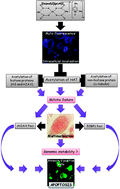In this study, we investigated mitotic catastrophe followed by apoptosis induced in human cell lines [HeLa, HepG2 and THP1] by a novel Cu(II) complex having malonate as the primary ligand and protonated 2-amino-4-picoline as the counter ion; whose in vitro DNA binding ability was demonstrated previously (B. Saha et al., J. Phys. Chem. B, 2010, 114(17), 5851–5861). Using the auto-fluorescence property of the complex, it was observed that the complex entered into the cells within 15 min after the exposure and was able to kill cells as determined by clonogenic survivability and MTT assay in a dose and time dependent manner. While dissecting the cell killing mechanisms, it was found that initially the complex induced multinucleated cells by inhibiting acetylation of a histone acetyl transferase (HAT) domain of CBP/p300, although histone deacetylase 6 (HDAC6) expression did not change much. As a result, histone proteins, H3 and H2AX, along with a non-histone protein, α-tubulin, were mostly deacetylated after 48 h of the treatment. This eventually led to mitotic catastrophe (MC), as histone acetylation–deacetylation dynamics is essential for the successful mitosis. DNA damage-induced γH2AX and 53BP1 foci in the treated cells were also observed after 72 h of treatment, as abnormal mitosis with decondensed chromosomes are prone to nucleolytic attack. These molecular phenomena ultimately rendered apoptosis. Taken together, our results provided evidence that the said complex perturbed the signaling events associated with mitosis and consequently induced cell death.


 Please wait while we load your content...
Please wait while we load your content...